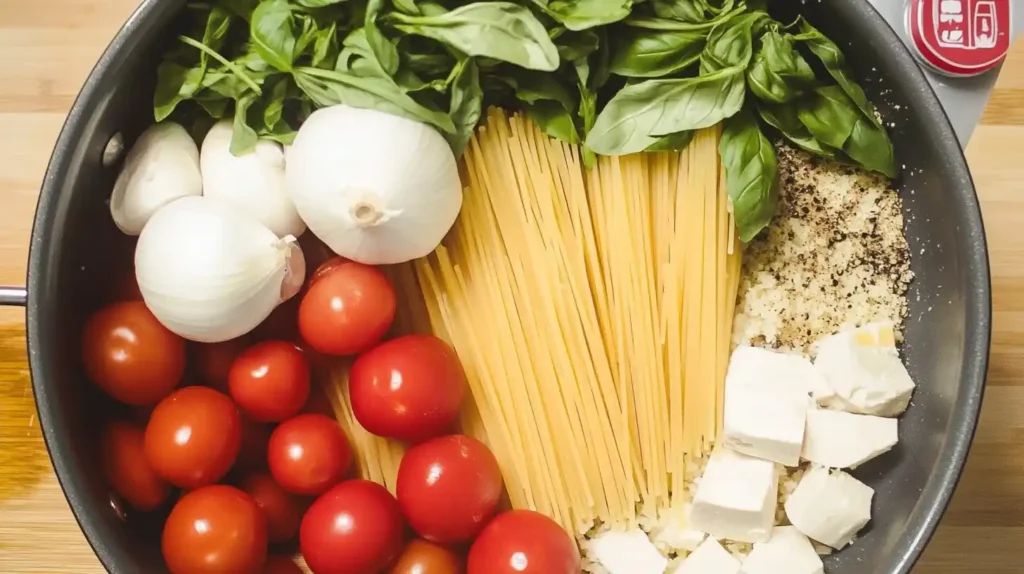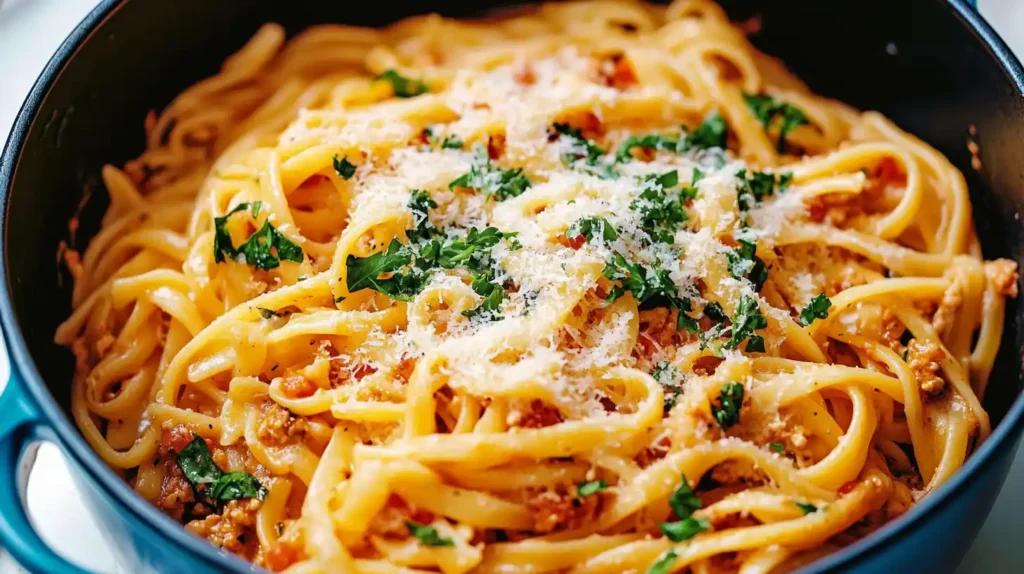This guide teaches you everything about making one-pot pasta. We’ll cover why it’s great, what ingredients you need, different ways to make it, and step-by-step instructions. We’ll also show you how to avoid common mistakes.
What is One-Pot Pasta?
Simple Cooking Method
One-pot pasta means you cook everything in one pot. This makes cooking easier and faster. You don’t need to boil water separately for the pasta.
Less Cleanup
The best part? Less mess! You only have one pot to wash. This saves you time and effort after your meal.
Delicious and Easy
One-pot pasta tastes great. It’s a simple way to make a delicious and satisfying meal. Many different recipes exist, letting you explore various flavors. You can easily adapt recipes to use what you have on hand.
Why is it Popular?
One-pot pasta is popular because it’s convenient. It’s perfect for busy weeknights when you want a tasty meal without a lot of work. The simple cooking method and minimal cleanup make it a favorite for many people.
One-Pot Pasta Ingredients
Pasta Choices
Many pasta shapes work well in one-pot pasta. Short shapes, like penne, rotini, or farfalle, are good choices because they cook evenly and don’t get too mushy. Longer pasta, like spaghetti, can also be used, but you might need to break it in half.
Broth Basics
The broth is the base of your flavor. Chicken broth is a popular choice, but you can also use beef broth, vegetable broth, or even water with bouillon cubes. Broth adds flavor and helps the pasta cook.
Veggies and Flavor
Vegetables add taste and nutrients. Onions, garlic, carrots, and celery are common additions. You can also use spinach, mushrooms, or other veggies you like.
Seasoning Suggestions
Seasonings make your one-pot pasta special. Salt and pepper are essential. Other options include Italian seasoning, herbs like basil or oregano, or even a little vinager for extra tang. Beef bacon adds smoky flavor. Experiment with different seasonings to find your favorite combinations!
Choosing the Right Pasta
Pasta Shapes for One-Pot Cooking
This section helps you pick the best pasta for your one-pot meal. Short pasta shapes work best. Why? They cook evenly. Longer pasta can break, making it harder to eat.
Good choices include penne, rotini, and farfalle. These shapes cook well in the sauce without becoming mushy. If you use longer pasta like spaghetti, break it in half before adding it to the pot. This ensures even cooking.
Why Some Pasta Shapes are Better
The shape affects how the pasta cooks and how well it absorbs the sauce. Small, oddly shaped pasta are best because they have more surface area. This means more of the sauce sticks to the noodles, giving you a tastier dish. Long, thin noodles can clump together and become unevenly cooked in a one-pot dish.
One-Pot Pasta Ingredients
| Ingredients | Quantity | Note |
|---|---|---|
| Pasta (short shapes preferred) | 1 cup | Penne, rotini, or farfalle work well |
| Broth (chicken, beef, vegetable, or water with bouillon) | 4 cups | Adjust based on recipe |
| Onions | 1 medium, chopped | Adds flavor |
| Garlic | 2 cloves, minced | Adds flavor |
| Carrots | 1 cup, chopped | Adds sweetness and color |
| Celery | 1/2 cup, chopped | Adds a subtle flavor |
| Salt and Pepper | To taste | Essential seasonings |
| Italian Seasoning or other herbs | To taste | Adds extra flavor |
| Beef bacon (optional) | 2-3 slices, chopped | Adds smoky flavor |
| Vinager (optional) | A splash | Adds a tangy taste |

Flavorful One-Pot Pasta
Broth Power
The broth you choose makes a big difference. Chicken broth is common, but beef broth adds a richer taste, and vegetable broth is perfect for vegetarians. You can even use water with bouillon cubes for a simple base. Each broth gives your pasta a unique flavor.
Herb and Spice Magic
Herbs and spices add tons of flavor. Dried Italian seasoning is easy, or you can use fresh herbs like basil or oregano. A little bit of vinager can add a nice tang. For a smoky taste, try adding some chopped beef bacon. Experiment to find what you like best!
Beyond the Basics
Don’t be afraid to try new things! Adding a pinch of red pepper flakes can give your pasta a kick. Garlic powder and onion powder are also good options for extra flavor. Remember, it’s all about finding the taste combinations you enjoy the most.
Adding Vegetables to Your One-Pot Pasta
Fresh, Frozen, or Canned?
You can use fresh, frozen, or canned vegetables in your one-pot pasta. Fresh vegetables taste best, but frozen and canned are convenient. If using frozen vegetables, add them a little later in the cooking process to prevent them from becoming mushy. Canned vegetables usually need less cooking time.
Timing is Key
Different vegetables cook at different speeds. Harder vegetables like carrots and celery should go in first, while softer vegetables like spinach and mushrooms should be added later. Check the package instructions for frozen or canned vegetables for cooking time suggestions.
Vegetable Choices
Onions and garlic add flavor to almost any one-pot pasta. Carrots and celery are also great additions, providing sweetness and a little crunch. Other vegetables to try include mushrooms, bell peppers, peas, and corn. Spinach, zucchini, and tomatoes add color and nutrition. Don’t be afraid to experiment with your favorites!
Adding Vegetables to Your Recipe
Add your harder vegetables along with the onions and garlic at the beginning. Add softer vegetables about halfway through the cooking time. Taste test and add more vegetables if you like. Remember to adjust your cooking time depending on the types and amounts of vegetables you add.
Making One-Pot Pasta: A Step-by-Step Guide
Cooking One-Pot Pasta on the Stovetop
First, get a large pot. Add your broth (chicken, beef, vegetable, or water with bouillon cubes). Then, add chopped onions, garlic, carrots, and celery. Let these cook until softened, about 5-7 minutes. Next, add your pasta and any beef bacon. Stir everything together. Bring the mixture to a boil, then reduce heat to a simmer. Cover the pot and cook according to the pasta package directions, stirring occasionally. The pasta is done when it’s tender and most of the liquid is absorbed.
Avoiding Common Mistakes
Don’t overcook the pasta! It can become mushy. Stir occasionally to prevent sticking. Add harder vegetables earlier than softer ones. Taste and season with salt, pepper, Italian seasoning, and a splash of vinager as needed. If using frozen vegetables, add them toward the end of the cooking time. If your sauce is too watery, continue to simmer uncovered until it thickens. Remember, adjusting the cooking time might be necessary depending on your ingredients and stove.
Flavorful One-Pot Pasta Recipes
Easy Tomato Pasta
This is a simple recipe. You’ll need one cup of short pasta, four cups of tomato broth, one chopped onion, two minced garlic cloves, and salt and pepper. Cook the onion and garlic in the broth until soft. Add the pasta and simmer until cooked. Season to taste.
Vegetable Delight
Add more veggies! Try one cup of chopped carrots and ½ cup of chopped celery along with the onion and garlic. Use vegetable broth for a vegetarian option. Add spinach or mushrooms near the end for extra flavor and nutrition.
Beef Bacon and Cheese
For a richer flavor, add 2-3 slices of chopped beef bacon along with the onion and garlic. Use chicken broth and sprinkle shredded cheese on top before serving.
Spicy Sausage Pasta
Use Italian sausage instead of beef bacon. Brown the sausage before adding other ingredients. Use a spicy Italian seasoning blend for extra heat.
Creamy Mushroom Pasta
Sauté mushrooms with the onion and garlic. Use cream-based vegetable broth for a creamy sauce. Add a sprinkle of Parmesan cheese. This recipe is perfect for a cozy meal.
Troubleshooting One-Pot Pasta
Pasta Too Soft?
Overcooked pasta is a common problem. Make sure you follow the cooking time on the pasta package. Don’t cook it for longer than needed. Stirring occasionally helps prevent sticking and ensures even cooking.
Sauce Too Watery?
If your sauce is too watery, let it simmer uncovered for a few more minutes. This lets extra liquid evaporate, making the sauce thicker.
Sauce Too Thick?
Add a little more broth to thin out a thick sauce. Start with a small amount and add more as needed. Stir well to combine.
Pasta Sticking?
Stir the pasta frequently while it cooks to prevent it from sticking to the bottom of the pot. Using enough broth also helps keep things moving.
Not Enough Flavor?
Taste your pasta as it cooks and add more salt, pepper, herbs, or spices as needed. Beef bacon, vinager, or a pinch of red pepper flakes can add extra flavor. Experiment with different herbs and spices to find what you like.
Frequently Asked Questions
What is the best type of pasta for one-pot recipes?
Short pasta shapes like penne, rotini, or farfalle work best because they cook evenly and don’t get mushy. Longer pasta can be used, but you may need to break it in half.
Can I use different types of broth?
Yes! Chicken broth is popular, but beef broth, vegetable broth, or even water with bouillon cubes will work. Each broth gives a unique flavor.
What vegetables can I add?
Onions, garlic, carrots, and celery are common additions, but you can add many others, such as mushrooms, spinach, bell peppers, or peas. Add harder vegetables first, and softer ones later.
How do I make sure my pasta doesn’t stick?
Stir occasionally to prevent sticking. Using enough broth also helps.
What if my sauce is too watery or too thick?
If it’s too watery, simmer uncovered until it thickens. If it’s too thick, add a little more broth.
Making One-Pot Pasta: A Delicious Conclusion
Easy, Fun, and Delicious
Making one-pot pasta is easy, fun, and delicious! You learned how to make tasty meals quickly with less cleanup. This guide showed you simple ways to cook pasta and explore different flavors.
Minimal Cleanup, Maximum Flavor
The best part of one-pot pasta is the easy cleanup. One pot means less washing up after dinner. You still get delicious, satisfying meals. You can easily change recipes to use what you have.
Keep Cooking!
Now you know the basics of one-pot pasta. Keep trying new recipes and ingredients. Have fun experimenting with flavors and vegetables! Enjoy your tasty and easy meals.
metadescription: Learn how to make delicious and easy one-pot pasta! This guide provides step-by-step instructions, recipe variations, and troubleshooting tips.
seo_title: Mastering One-Pot Pasta: The Ultimate Guide

